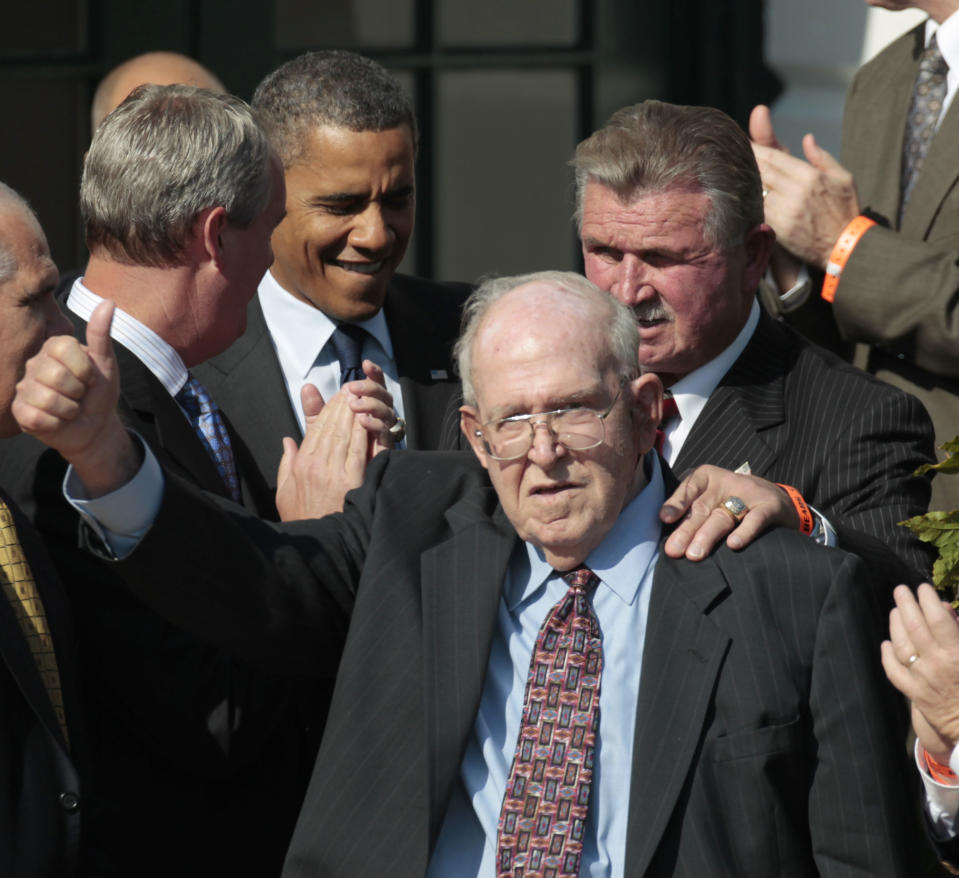Buddy Ryan was a product of the past, but his legend will live on
Professional football has changed in many ways since members of the Chicago Bears defense lifted Buddy Ryan off the Superdome’s artificial turf and onto their shoulders 30 years ago.
Quarterbacks have been protected by the game’s rules more as the dangerous effects of concussions have become clear. Bill Belichick’s buttoned-up approach has turned assistant coaches into staff members who should be seen only on Sundays and not heard in the media during the week. The evolution of pro offenses, particularly Bill Walsh’s West Coast scheme and its multi-receiver sets, made Ryan’s 46 defense a relic by the late ’80s.
It’s hard to imagine that the hard-nosed Korean War vet who was born without a filter would’ve become a legend had he coached today.
It’s not hard to imagine, however, that Ryan’s legend will continue to grow, even after his death Tuesday at the age of 85. Though the NFL might be a changed place, plenty of the league’s fans still prefer to see themselves in Ryan and the approach he brought to his gameplans.
Like his famous NFL coaching sons Rex and Rob, Buddy was brash, outspoken and unapologetic. He never met a pass rush he didn’t like, and the sooner a starting quarterback could be sent for the smelling salts the better. He liked his blitzes big and his hits bigger.
Ryan famously did things his way or he didn’t do them at all. As defensive coordinator of the 1985 Bears, Ryan famously maintained a public feud with head coach Mike Ditka and more or less split the team in two. Ryan resented that a former tight end such as Ditka might pretend to know anything about defense and often refused to refer to him by his name when talking to his charges. If you watched the “‘85 Bears,” the recent “30 for 30” documentary in which Ryan played a key role, you could still sense the lack of respect that some of Ryan’s guys held for Ditka.
At the same time, you got the feeling they would have still run through a wall had Ryan commanded it, even as an octogenarian ravaged by three bouts with cancer and slowly dying on his Kentucky horse farm.
“Without Buddy Ryan, I’m just a guy,” Hall of Fame linebacker Mike Singletary said during an emotional visit with Ryan during the film.
Singletary went on Chicago sports talk radio Tuesday morning and called Ryan the second coming of General George S. Patton. If you excuse Ryan’s more trivial role as a football coach — as well as his middling 55-55-1 head coaching record with the Philadelphia Eagles and Arizona Cardinals — it wasn’t a bad comparison.
MIke Singletary on Buddy Ryan: "He's kind of the second coming of General Patton."
— 670 The Score (@670TheScore) June 28, 2016
Like Patton, Ryan was a pioneering tactician who favored aggression. Both inspired extreme loyalty from their men despite being demanding and overbearing. Both were responsible for two of the most important victories of the 20th century: Patton and the Allied army in World War II, Ryan with Singletary and Co. in Super Bowl XX. (OK, OK, so this Bears fan might be overstating things a bit there, but I can guarantee readers with 312 and 773 area codes are reading that sentence without any sense of irony).
In the years since his retirement, Ryan become a folk hero of sorts in NFL circles, thanks to many of the men who extolled his virtues after their playing days. Those testimonials helped his reputation get past embarrassing points of his career such as his zero playoff victories, despite three appearances with the Eagles, or famously throwing a punch at offensive coordinator Kevin Gilbride during a 1994 game with the Houston Oilers.
(His two-sided cold war with Ditka also thawed as years went by with both men ultimately admitting that neither man would have won without the other — a fact that was proven because neither Ditka nor Ryan ever won another Super Bowl after 1985.)

Truth be told, Ryan’s diverse career always had a Forrest Gump-type feel to it. He engineered the New York Jets’ 16-7 upset of the Baltimore Colts in Super Bowl III, leading an effort that saw the defense intercept Earl Morrall and Johnny Unitas four times. He then moved onto the Minnesota Vikings, where he reached multiple Super Bowls by coaching the team’s famed “Purple People Eaters” defensive line.
Ryan’s legacy, however, will always be defined by being the architect of the 1985 Bears defense that sidelined quarterbacks and kept two opponents off the scoreboard during the playoffs. While some might argue the 2000 Ravens surpassed them in achievement, those Monsters of the Midway remain the default starting point any time someone wants to establish where stalwart squads like the 2013 Seahawks or 2015 Broncos rank.
That achievement is a part of the reason that Ryan will remain the most notable and popular assistant coach in NFL history.
Being one of the most colorful and complex characters in league history will carry Ryan’s legacy the rest of the way. Equal part mercurial and mad genius, abrasive and endearing, Ryan is still the picture of what many fans picture a football coach to be.
– – – – – – –
Kevin Kaduk is a writer for Yahoo Sports. Have a tip? Email him at kevinkaduk@yahoo.com or follow him on Twitter!


